After studying over this page, you should be able to determine wind direction and relative wind speed based on two common types of weather maps, 500 mb height maps, which we have already studied, and surface weather maps. The basic forces that cause the wind to blow are described, but not in rigorous detail. The main reason to go over this material now is that we are going to try to describe both the surface winds and the 500 mb winds that are typical with middle latitude storm systems. Later in the semester we cover hurricanes and the winds both at the surface and at 500 mb are important in understanding hurricane strengthening and movement.
In describing weather, wind is generally taken to mean the horizontal movement of air. By convention, the wind direction is the direction from which the wind is blowing (e.g., a north wind means the air is moving from north toward south) and the windspeed is the speed at which the air is moving relative to the ground. Surface winds blow along the surface of the Earth where we live. But there are also winds blowing along horizontal paths at altitudes above the ground surface, for instance, the 500 mb winds that have been previously discussed. Weather maps show the pattern of air pressure. Using this information we can visually determine the approximate wind pattern.
All winds result from horizontal differences in air pressure. Basically, air is forced or pushed from regions of higher air pressure toward lower air pressure. Consider a sealed box of air. The pressure of the air inside the box pushes outward on the box. One way to increase the air pressure inside the box is to pump more air into the box. This increases the force of air pushing out. If you pop a hole in the box, air will be forced outward, from higher pressure inside the box toward lower pressure outside the box. This is an example of wind on a small scale. This also explains why air rushes in when you open a vacuum sealed container (like a jar of food); it explains why air rushes out when you open a carbonated beverage sealed under high pressure (like soda or beer); and how it is that we breath (expanding our lungs initally lowers the air pressure inside, causing higher pressure air outside to rush in). In all cases, air is forced to move from high toward low pressure and the greater the difference in pressure, the stronger the force on the air, and the faster the air moves. For small scale air motions, like the soda can, the wind blows directly from higher toward lower pressure. For large scale motions, like those we are going to study with weather maps, the wind direction will not be directly from higher to lower pressure since other forces must be considered.
![[pgf]](pgf_schem.gif)
|
| Schematic Drawing of the Pressure Gradient Force (PGF). Notice that both the direction and magnitude (strength) of the force are indicated. |
The pressure gradient describes both the direction of the pressure change (from high toward low pressure) and the strength of the pressure change (change in air pressure divided by the distance over which the pressure changes). The pressure gradient results in a pressure gradient force, which pushes air in the direction of the pressure gradient. The stronger the pressure gradient, the stronger the pressure gradient force and the stronger the winds. The image on the left is similar to how pressure information is plotted on surface weather maps. The air pressure is 1012 mb at the "H" (highest pressure in image) and the air pressure is 1004 mb at the "L" (lowest pressure in image). The pressure gradient force pushes from high to low pressure as shown by the blue arrow. The strength of the pressure gradient is the change in pressure divided by the change in distance as shown. The most important point for now is that you understand what is meant by a pressure gradient and a pressure gradient force, not whether or not you can calculate a number based on a weather map. Also keep in mind that while the pressure gradient force is the root cause of all wind, there are other forces that must be considered to determine the direction of the wind. For large scale motions, like those inferred from common weather maps, the wind direction is NOT in the same direction as the pressure gradient force. This will be desribed later on this page.
Although air pressure changes rapidly along the vertical direction, this does not cause the air to move upward due to hydrostatic balance, in which the upward pressure gradient force is balanced by the weight of the air above. As mentioned previously, air pressure gets lower as you move upward in elevation since the air pressure is caused by the weight of the air above a given point. This is explained in more detail in later lectures. This means the vertical pressure gradient force points upward from higher to lower air pressure. This upward pressure gradient force is just enough to hold up the weight of the air above it. The near balance of forces means that air does not easily move up or down in the atmosphere. However, even small changes in air pressure along a horizontal surface result in winds (horizontal movement of air) since there is no balancing force. What is important for understanding winds (the horizontal movement of air) is to identify how the air pressure changes along a horizontal surface.
On this page we will look at how wind information can be inferred from common weather maps, which depict how air pressure changes along horizontal surfaces.
Station pressure is defined as the barometer reading observed at ground level at a given meteorological station. A barometer is an instrument used to measure air pressure. The surface level air pressures measured all around the world can be plotted on a weather map to show the pattern of air pressure changes. The problem with using measured station pressure though is that not all weather observation stations are located at the same altitude. Higher altitude locations will measure lower air pressure than lower altitude stations, since air pressure falls off so rapidly as one moves upward in elevation.
Recall that winds are caused by changes in air pressure along a horizontal (constant elevation) surface and that changes in pressure along vertical surfaces do not cause winds. Cities separated by just a few kilometers might have very different station pressures due to differences in station altitude. Thus, to properly monitor horizontal changes in pressure, surface barometer readings must be adjusted to a common altitude to eliminate the pressure differences due to differences in station altitude. Again, the purpose of the altitude adjustment to the measured station pressure is to have all the pressure measurements be at the same altitude because it is the change in pressure along a horizontal surface that causes winds.
Altitude adjustments are made so that a barometer reading taken at one elevation can be compared with a barometer reading taken at another to compute the horizontal change in air pressure. Station pressures are normally adjusted to a altitude level of mean sea level and the adjusted pressure is called Sea level pressure. The size of the adjustment depends primarily on how high the station is above sea level. For example, Tucson is about 2500 feet (760 meters) above sea level. A typical station pressure for Tucson would be in the range 910-930 mb, which is much lower than a station pressure measured at a location near sea level, like San Diego, which is typically around 1013 mb. In order to eliminate the pressure difference that is due to elevation differences, i.e., the part that does not contribute to winds along the ground, the Tucson station pressure is converted to sea level pressure, which is basically what the air pressure would be in Tucson if Tucson were at the altitude of sea level. You should realize that for Tucson (and any other location located at an altitude above sea level) the sea level pressure will be greater than the station pressure. This is simply because air pressure will always decrease as one moves upward in the atmosphere.
Compare the current Tucson station pressure with the altitude-adjusted sea level pressure, which are shown in this link under the heading "Pressure". You may also wish to look at the sea level pressure graph over the last 24 hours in Tucson Stations located at even higher altitudes will measure smaller station pressures and a larger adjustment is needed to convert to sea level pressure. A list of current station and the adjusted sea level pressures for cities near the Denver, Colorado area is shown in this link. Look at the column headed "mb or hpascals" and compare the first row (station pressure) with the third row (adjusted sea level pressure) for each of the observation stations listed. Notice that the higher elevation stations have a lower station pressure. The other columns in the table are just different units for measuring air pressure. The basic concept of adjusting the station pressure to account for pressure differences caused by stations being at different altitudes should make sense to you. However, the details of how exactly this is done can become complicated and you are not expected to know how to calculate sea level pressure from station pressure. You should understand why it is necessary though.
![[pgf]](sfcpress_example.jpg) |
Sea level pressure (in millibars) is what is plotted on surface weather charts. Isobars are lines connecting points of equal pressure. The analysis of the sea level pressure data allows for the pressure pattern to be visualized. Again, the reason we plot out the pressure pattern is that winds are forced by changes in pressure along horizontal surfaces. These "maps" are called sea level pressure charts or surface weather maps. An example of a surface weather map with isobars is shown on the left. The surface pressure map indicates a strong low (L, 985 mb) over Nebraska and a weak high (H, 1016 mb) near the Great Lakes. Lows mark where a center of lowest pressure is found and highs mark where a center of highest pressure is found. Note that the change in pressure along a horizontal direction can be determined by examining the pattern of isobars. The more closely packed the isobars, the greater the pressure gradient which is the change in pressure divided by the distance over which that pressure change happens. The stength of the pressure gradient is what determines the strength of the winds. The greater the pressure gradient, the stronger the windspeed. Thus, on surface weather maps, the strongest winds are happening where the isobars are closest together and the weakest winds are happening where the isobars are spaced furthest apart. You can see that the isobars on April 8 were tightly packed over Colorado, so the pressure changed rapidly over the relatively short distance from the center of the low to western Colorado. This strong pressure gradient produced wind gusts over 100 mph, and the storm caused $13.8 million in damage in Colorado in a two-day period. Meanwhile weak winds would be expected across much of the eastern United States where the isobars are spread apart and the pressure gradient is weak.
The current sea level weather chart for the United States can be found at WW2010 at
the University of Illinois (Click on the image labeled "isobars"). On most days, you will not find strong
pressure gradients (closely packed isobars) on surface weather maps as seen in the example above.
Fortunately, strong pressure gradients and strong winds at the surface only happen occasionally in
association with strong weather systems. However, the weather is more interesting when strong
weather systems are present, and I would like you to be able to identify strong weather systems
on surface weather maps. The links below show the surface weather maps on two days with strong storm
systems:
Sea level chart for August 29, 2005 (Hurricane Katrina)
Sea level chart for October 29, 2012 (Superstorm Sandy)
The tight packing of isobars is easily seen on the Superstorm Sandy map. At first glance Hurricane Katrina looks much weaker
in that the isobars are not as tightly packed. However, notice that the spacing of the isobars near Katrina is every
8 mb, instead of every 4 mb like it is on the rest of the map (and most other maps). So to properly compare the pressure gradients
on the maps, near Katrina there should be another isobar drawn between each of the isobars that encircle the center of the storm.
So far we have only discussed how to determine the relative strenth of the wind, but not the wind direction. The relationship between the pressure pattern and direction that surface winds are blowing is explained after the next section on upper air charts.
Horizonal winds blowing at different altitudes above sea level are also very important in determining what is going on with the weather. Upper air weather charts are drawn to visualize pressure patterns at different altitudes. We have also used the 500 mb upper air chart to get a picture of the large-scale weather pattern around the North America.
While surface weather charts depict the pressure pattern at a fixed altitude (sea level), upper air charts depict a pattern showing how the altitude of a fixed pressure surface changes. There are maps showing the height pattern at 850 mb, 700 mb, 500 mb, 300 mb, and so on. We have previously looked at 500 mb height maps and discussed 500 mb winds. It is very important to realize that the height patterns shown on upper air maps give you the same information about changes in pressure along a horizontal surface that surface maps do, just at different altitudes. Thus, the pattern of height contours indicate how air pressure varies along horizontal surfaces, for a horizontal surface located where the air pressure is 500 mb. Air is forced or pushed from higher heights toward lower heights and the more closely spaced the height contours, the stronger the pressure gradient and the stronger the winds. This is simply a re-statement of what was previously described about 500 mb winds. Again this only covers the strength of the wind, based on the pressure gradient information obtained from examining the upper air height contours on a weather map, but not the wind direction.
Because the driving force for all wind is the horizontal change in pressure, the greater the horizontal change in pressure (or more precisely the pressure gradient), the greater the windspeed. The pressure gradient is the horizontal change in pressure divided by the horizontal change in distance. On a weather chart, the magnitude of the pressure gradient can be seen by examining the spacing between the contour lines of the map (isobars on the surface map or height contours on the upper air map). Where the lines are closest together, the horizontal change in pressure is stronger, and the winds are stronger. In other words, higher windspeeds are found where the contour lines are closest together. The force exerted on air by changes in air pressure is known as the pressure gradient force. The direction of the pressure gradient force is from higher pressure toward lower pressure. Thus on weather maps, the pressure gradient force points most directly from higher contour values toward lower contour values and is perpendicular to the contours, i.e., if the pressure gradient were drawn on weather maps, it would be shown as arrows pointing from high toward low contour values on the map (examples are provided below). Since the pressure gradient force is the root cause of all winds, you might think the wind direction would be directly from high to low pressure, but this is not the case due to the Earth's planetary rotation.
Over short distance scales, air moves in the direction forced by the horizontal pressure changes, i.e., directly from high toward low pressure. This is the case for the examples of opening a jar of food or a can of soda mentioned above. However, for large-scale air motions (like the ones depicted on weather maps), the actual wind direction is turned away from this direction because the Earth is rotating. This phenonemon is called the Coriolis effect or Coriolis force. The details of the Coriolis effect are difficult to understand, so we will not go into them. Basically, it comes about because we are observing the wind from a rotating frame of reference. We are attached to the surface of the Earth and are rotating with it, while the air above is not attached and thus does not have to rotate with it. It is important to understand that the Coriolis effect is only important for motions that traverse long distances or last long enough for the Earth to move significantly in its rotation. Thus, the Coriolis effect is not significant when shooting a basketball and does NOT affect the direction that water swirls down a drain. The Coriolis effect is significant for determining the direction of large scale winds from weather charts, the direction of ocean currents, or the paths of long-range missles and airplanes.
See this basic description of the Coriolis effect. Play the merry-go-round video, which is a good demonstration for how the Coriolis force works. Notice that observer looking down on the merry-go-round in a frame of reference that is not rotating sees the ball move in a straight line, which can be easily explained by the laws of motion, i.e., the ball was pushed in one direction and it moves in that direction. However, for someone observing the ball on the merry-go-round in a frame of reference that is spinning clockwise, the ball appears to curve to the left. In order to explain this using the laws of motion, there needs to be a force that causes the ball to curve. This force is known as the Coriolis Force and will be important when observing motions on a rotating frame of reference. Since the Earth is rotating and we are on it, we observe motions from a rotating frame of reference. The linked video shows the merry-go-round rotating clockwise. This is the situation in the southern hemisphere of the Earth. For observers in the northern hemisphere, the rotation is counterclockwise, and the Coriolis force will deflect objects to the right. See these animations showing how the paths of airplanes in the northern and southern hemisphere are deflected by the Coriolis effect. You are only expected to understand the outcome of the Coriolis force, not the details of how it works.
Therefore, the Coriolis force turns the wind to the right (of the pressure gradient) in the northern hemisphere and to the left (of the pressure gradient) in the southern hemisphere. We will only worry about the northern hemisphere. At all altitude levels above the ground surface (includes all upper air charts, but not surface charts), the wind direction is 90° to the right of the direction of the pressure gradient force. The pressure gradient force is directed from high heights (or pressures) toward low heights (or pressures). Thus, on upper air charts the wind moves parallel to the height contours, with lower heights to the left of the wind direction. This was the basic rule given to estimate wind speed and direction on 500 mb charts in the previous reading page. Now you should understand a bit more about why the wind blows as it does at 500 mb. See figures below.
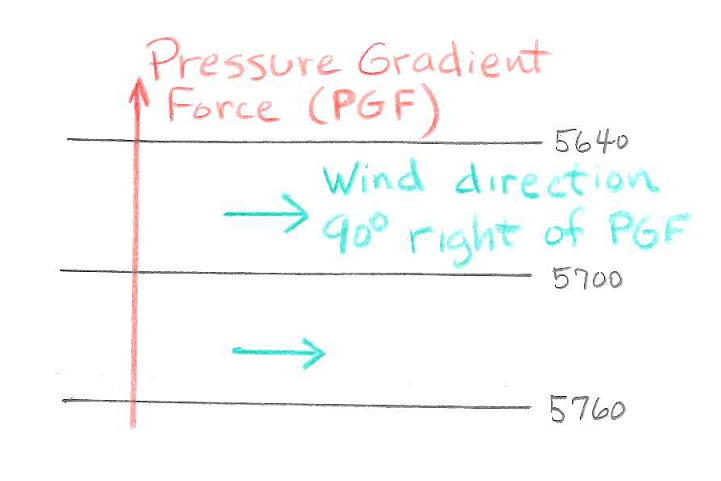
Sample 500 mb map showing height contours in black. The direction of the pressure gradient force (from high to low heights) is shown in red. The wind direction at 500 mb, shown in blue, is turned 90° to the right of the pressure gradient force due to the Coriolis Effect. |
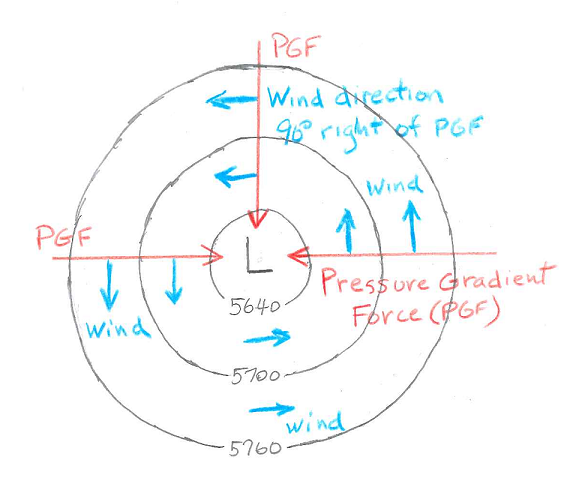
Sample 500 mb map depicting a closed low. The direction of the pressure gradient force is inward toward the low. The wind direction is 90° to the right of the pressure gradient force and flows counterclockwise around the center of the closed low. |
Because air moving along the ground surface is slowed by friction with the ground, there is a third important force, a frictional or drag force due to contact with the ground, which complicates the direction of air flow along the ground. A general rule of thumb is that the wind direction just above the ground surface is only turned about 60° to the right of the pressure gradient force, instead of 90° right of the pressure gradient force as it is on uppper air maps. Thus, on surface weather charts the wind direction, rather than being parallel to the isobars, points about 30° toward lower pressure. I suggest using a two step process to determine wind direction using a surface weather map. Step 1 is to find the direction that is parallel to the isobars with lower air pressure to the left and higher air pressure to the right. This is 90° to the right of the direction of the pressure gradient. This is the same as the wind direction on 500 mb maps. Step 2 is to take this direction and turn it 30° toward lower pressure. This is the wind direction. See figures below.
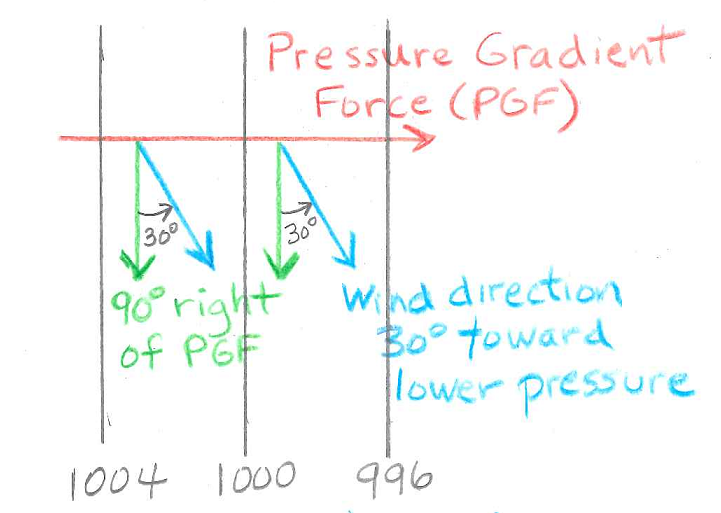
Sample surface map showing isobars of sea level pressure in black. The direction of the pressure gradient force (from high to low pressure) is shown in red. The direction 90° to the right of the pressure gradient force is shown in green. On surface maps the wind direction, shown in blue, is not parallel to the contours, but is 30° toward lower pressure as shown. |
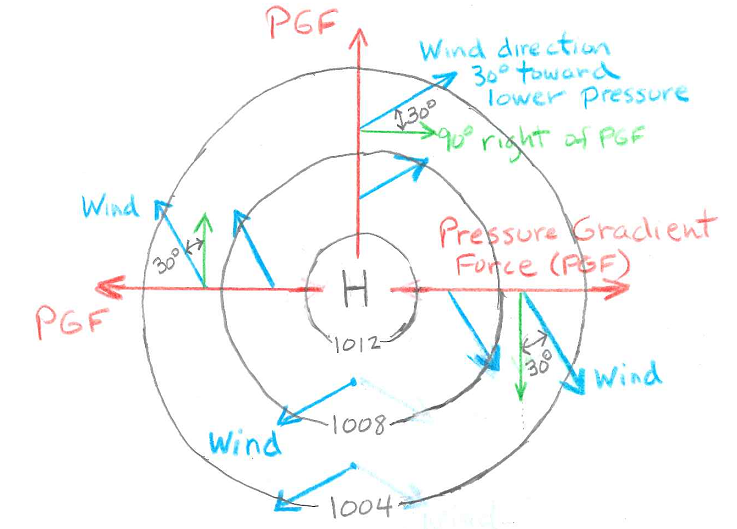
Sample surface map depicting a closed high. The direction of the pressure gradient force is outward away from the center of the high. As depicted in the caption under the figure to the left, to find the wind direction, first find the direction 90° to the right of the pressure gradient force, then the wind direction is 30° toward lower pressure. The wind pattern near a surface high pressure is clockwise around the high, but also spiraling outward away from the high. |
An important consequence of the fact that winds just above the ground surface do not blow parallel to the isobars, but slightly toward low pressure (and away from high pressure), is that sea level pressure pattern and winds can force air to move upward or downward. Later in the semester we will show that upward moving air is associated with cloud formation and precipiation, while downwarn moving air is assoicated with fair weather and a lack of clouds. First a couple of definitions. The wind pattern is said to be convergent in regions where there is a horizontal inflow of air toward the region and divergent in regions where there is a horizontal outflow of air away from a region. The pattern of the arrows in the figures below show examples examples of purely convergent and divergent air flow.

Instructive images for horizonal convergence or air. Arrows show horizontal wind pattern. Left side shows covergence toward a line, while right side shows convergence toward a point, which is what happens near circular surface low pressure systems. |
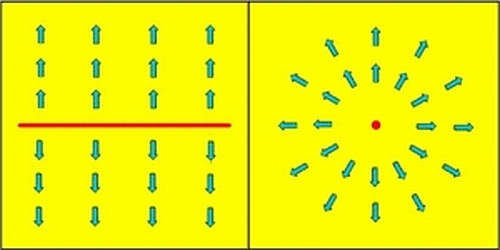
Instructive images for horizonal divergence or air. Arrows show horizontal wind pattern. Left side shows divergence away from a line, while right side shows divergence away from a point, which is what happens near circular surface high pressure systems. |
Of importance for weather, when the horizontal air flow at the surface is convergent (flowing together), air is forced to rise (move vertically upward). Conversely, when the horizontal air flow at the surface is divergent (flowing away), air is forced to sink (move vertically downward). To help you understand this relationship, think of air as a fluid that flows, just as water or even a tube of toothpaste. Squeezing a tube of toothpaste from the bottom is horizonal convergence. Toothpaste is forced upward by the convergence, just like air will be forced upward when there is horizontal convergence of air at ground level. In other words, squeezing air together near the ground forces some air to rise upward, since it cannot go down into the ground. Conversely, if you could pull apart a tube of toothpaste from the bottom, then paste from above will move down to fill the space. In other words, when air is flowing out of a region at the surface of the earth (divergence), air will sink down from above to fill the space.
Since the winds at the surface flow toward lower pressure and away from higher pressure, surface low pressure areas are associated with surface convergence, forced rising air, and a good possibility for clouds and precipitation, while surface high pressure areas are assoicated with surface divergence, forced sinking air, and generally fair, cloud-free weather. The figure below also shows that rising and sinking air can be forced by convergence and divergence from the top of the atmosphere as well. We will come back to upper level convergence and divergence later in the semester when we cover cool season weather. For now you should understand the relationships between the surface pressure pattern, surface winds, covergence or divergence, rising or sinking air, and the expected weather conditions. Following are two links that review this information, which you may find useful. One is a WORD document about winds and weather maps which includes figures and the other is an image document showing horizontal convergence, divergence, and vertical motion.
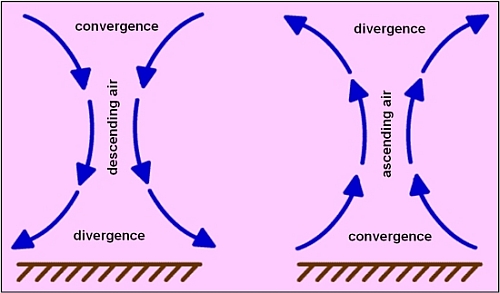
Relationship between horizontal covergence and divergence and vertical air motion. Left side shows that sinking air motion is forced by covergence at the top of the atmosphere and divergence at the surface. Surface divergence takes place near surface high pressure areas. Right side shows that rising air motion is forced by divergence at the top of the atmosphere and convergence at the surface. Surface convergence takes place near surface low pressure areas. |
Look again at the surface map for April 8 shown above on this page. You should now realize that the winds near the surface low over Nebraska will be counterclockwise and inward (converging), which forces air to rise upward. The winds will also be relatively strong due to the strong pressure gradient force (tight packing of the isobars). In fact, weather systems that produce both strong surface winds and significant precipitation will have surface low pressure at their center. The tight pressure gradient results in strong winds and the convergence and forced rising motion produces clouds and precipitation. The strongest of these low pressure systems are the epic storms of history. Examples of recent strong low pressure storms are Hurricane Katrina in 2005 and Superstorm Sandy in 2012. Generally strong winds are possible wherever strong pressure gradients form, not just with surface low pressure areas. Strong pressure gradients can occur in association with strong surface high pressure as well. The difference is that surface high pressure forces air to sink vertically, so there will not be much in the way of clouds and precipitation accompanying the strong winds.